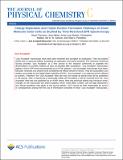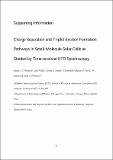Files in this item
Charge separation and triplet exciton formation pathways in small molecule solar cells as studied by time-resolved EPR spectroscopy
Item metadata
| dc.contributor.author | Thomson, Stuart | |
| dc.contributor.author | Niklas, Jens | |
| dc.contributor.author | Mardis, Kirsty Lynn | |
| dc.contributor.author | Mallares, Christopher | |
| dc.contributor.author | Samuel, Ifor D. W. | |
| dc.contributor.author | Poluektov, Oleg G. | |
| dc.date.accessioned | 2018-09-12T23:35:47Z | |
| dc.date.available | 2018-09-12T23:35:47Z | |
| dc.date.issued | 2017-10-19 | |
| dc.identifier | 250098697 | |
| dc.identifier | f7ee505c-9508-4f03-a759-a2077f7cd262 | |
| dc.identifier | 85031900488 | |
| dc.identifier | 000413617900013 | |
| dc.identifier.citation | Thomson , S , Niklas , J , Mardis , K L , Mallares , C , Samuel , I D W & Poluektov , O G 2017 , ' Charge separation and triplet exciton formation pathways in small molecule solar cells as studied by time-resolved EPR spectroscopy ' , Journal of Physical Chemistry C , vol. 121 , no. 41 , pp. 22707-22719 . https://doi.org/10.1021/acs.jpcc.7b08217 | en |
| dc.identifier.issn | 1932-7447 | |
| dc.identifier.uri | https://hdl.handle.net/10023/16019 | |
| dc.description | Funding: EPSRC EP/G03673X/1 (SAJT), Royal Society Wolfson research merit award (IDWS). | en |
| dc.description.abstract | Organic solar cells are a promising renewable energy technology, offering the advantages of mechanical flexibility and solution processability. An understanding of the electronic excited states and charge separation pathways in these systems is crucial if efficiencies are to be further improved. Here we use light induced electron paramagnetic resonance (LEPR) spectroscopy and density functional theory calculations (DFT) to study the electronic excited states, charge transfer (CT) dynamics and triplet exciton formation pathways in blends of the small molecule donors (DTS(FBTTh2)2, DTS(F2BTTh2)2, DTS(PTTh2)2, DTG(FBTTh2)2 and DTG(F2BTTh2)2) with the fullerene derivative PC61BM. Using high frequency EPR the g-tensor of the positive polaron on the donor molecules was determined. The experimental results are compared with DFT calculations which reveal that the spin density of the polaron is distributed over a dimer or trimer. Time-resolved EPR (TR-EPR) spectra attributed to singlet CT states were identified and the polarization patterns revealed similar charge separation dynamics in the four fluorobenzothiadiazole donors, while charge separation in the DTS(PTTh2)2 blend is slower. Using TR-EPR we also investigated the triplet exciton formation pathways in the blend. The polarization patterns reveal that the excitons originate from both intersystem crossing (ISC) and back electron transfer (BET) processes. The DTS(PTTh2)2 blend was found to contain substantially more triplet excitons formed by BET than the fluorobenzothiadiazole blends. The higher BET triplet exciton population in the DTS(PTTh2)2 blend is in accordance with the slower charge separation dynamics observed in this blend. | |
| dc.format.extent | 1412039 | |
| dc.format.extent | 2528315 | |
| dc.language.iso | eng | |
| dc.relation.ispartof | Journal of Physical Chemistry C | en |
| dc.subject | QC Physics | en |
| dc.subject | QD Chemistry | en |
| dc.subject | DAS | en |
| dc.subject | SDG 7 - Affordable and Clean Energy | en |
| dc.subject.lcc | QC | en |
| dc.subject.lcc | QD | en |
| dc.title | Charge separation and triplet exciton formation pathways in small molecule solar cells as studied by time-resolved EPR spectroscopy | en |
| dc.type | Journal article | en |
| dc.contributor.sponsor | The Royal Society | en |
| dc.contributor.institution | University of St Andrews. School of Physics and Astronomy | en |
| dc.contributor.institution | University of St Andrews. Condensed Matter Physics | en |
| dc.identifier.doi | https://doi.org/10.1021/acs.jpcc.7b08217 | |
| dc.description.status | Peer reviewed | en |
| dc.date.embargoedUntil | 2018-09-13 | |
| dc.identifier.grantnumber | en |
This item appears in the following Collection(s)
Items in the St Andrews Research Repository are protected by copyright, with all rights reserved, unless otherwise indicated.


